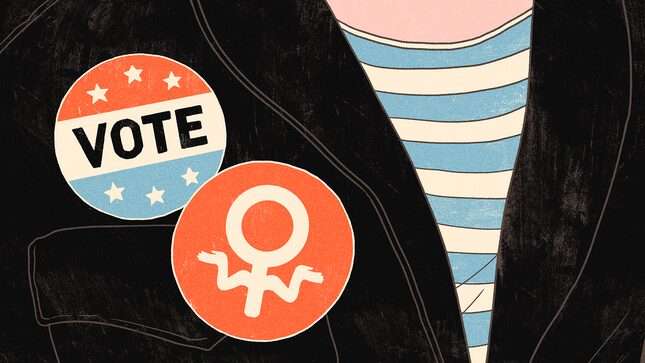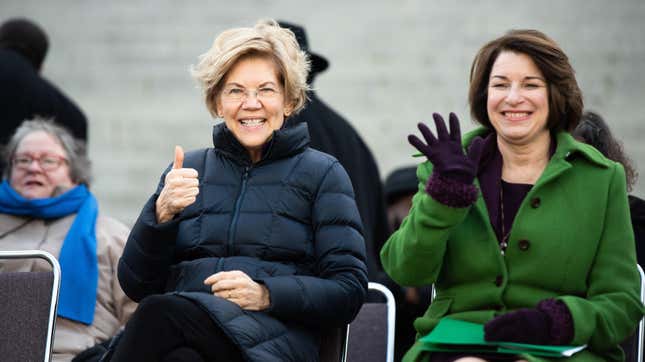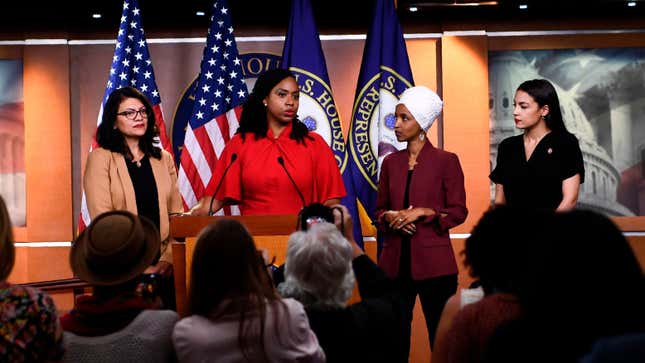There Was Boundless Energy for Women Candidates in 2018. Now, Just Apathy.
More women than ever ran for office four years ago, and the future, everyone said, was female. Where's that same energy for the 2022 midterms?
In DepthIn Depth
Illustration: Angelica Alzona
On the heels of the #MeToo movement and the election of our notorious “grab ‘em by the pussy” president, record-breaking numbers of women ran for Congress in 2018, making it the second so-called “Year of the Woman.” Ultimately, more than 100 women were elected to Congress in the midterms. It seemed that rather than depress political participation, Trump’s defeat of Hillary Clinton was a uniquely galvanizing moment for women: Between 2016 and 2018, the number of women running for office literally doubled. Then in 2020, for the first time ever, the New York Times endorsed not one but two women for president—Elizabeth Warren and Amy Klobuchar—and it really felt like the glass ceiling might finally be broken.
This year marks the 30th anniversary of the first Year of the Woman in 1992, when a wave of women ran for Congress following massive public backlash against the confirmation of Clarence Thomas to the Supreme Court, after Anita Hill testified before Congress that he had sexually harassed her. But the energy of both 1992 and 2018 seems to have been zapped.
Today, women candidates and campaign staff are navigating a starkly different political landscape. Among many liberal-leaning voters, the activist spirit that defined the Trump era has faded, and the energy and media frenzy surrounding liberal and progressive women candidates in particular has largely vanished—leaving them to struggle against the sexist barriers that have always constrained women in politics, but without the game-changing momentum that helped bridge these gaps in recent cycles.

Trump may no longer be in office, but that alone doesn’t change how women comprise just 27 percent of Congress members, only one-third of whom are women of color. On the state level across the country, a mere 31 percent of state legislators are women. Oh, and in the past 233 years, zero of the 46 presidents of the United States have been women. Despite the persistence of these disparities, with the Trump presidency in the rear-view and nearly five years since the rise of MeToo, much of the electorate now seems to be meeting the struggle for gender parity in politics with a shrug.
Christy Smith, a Democratic candidate for California’s 27th Congressional district this cycle, tells Jezebel the timing of this affliction of political apathy is particularly unfortunate, considering how much is at stake for women, pregnant people, families, and especially those from communities of color this election cycle: A Supreme Court case could effectively end Roe v. Wade, state-level attacks on trans people and their families are surging, and Congress is neglecting to take action around inaccessible child care—or, for that matter, the 41 percent rise in child poverty since the expiration of the Child Tax Credit in January.
Smith ran for California State Assembly and won in 2018. She ran for Congress in 2020 amid the pandemic, and lost by just 300 votes. She is now running for Congress again in one of the tightest races in the nation, with her state’s primary slated for June 7, and she says that this year, the enthusiasm around women like her who are running for office feels off in comparison with previous years. She theorizes that covid’s disproportionate impact on women’s time, energy, and economic circumstances has taken a toll on their political organizing capacities: “For many women, covid meant going back into full-time caregiving, whether for children, parents, or other loved ones, which makes it challenging to continue activism on top of their daily schedules—it’s something some have had to set aside, and we’re feeling the impacts of that.”
New York State Assembly member Yuh-Line Niou, who’s running for state Senate this cycle, echoes Smith’s concern that women candidates are battling complacency and even hostility among the electorate in a post-Trump political era. “People are just feeling tired and exhausted—there was a huge presidential election, then a literal insurrection at the Capitol,” Niou told Jezebel. “The politics just never seem to end. People are burnt out, sad, and angry all the time. It’s been nonstop the last two years.”
For many women, covid meant going back into full-time caregiving, whether for children, parents, or other loved ones, which makes it challenging to continue activism on top of their daily schedules.
As a Taiwanese-American woman, Niou felt particularly impacted by the Trump administration’s racism, including sharp attacks on Asian Americans at the onset of the pandemic. The Trump era increased visibility around women candidates, because they were the perfect political foil to the noted pussy-grabber-in-chief. But for women of color candidates, Trump also fanned the flames of racism and xenophobia that have often forced women like Niou to fear for their safety. Anti-Asian racism, harassment, and threats targeting her Senate campaign have continued and even escalated, today, more than a year after Trump left office.
-

-

-

-

-

-

-

-

-

-

-

-

-

-

-

-

-

-

-

-

-

-

-

-

-

-

-

-

-

-

-

-

-

-

-

-

-

-

-

-











































